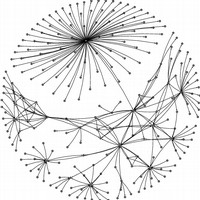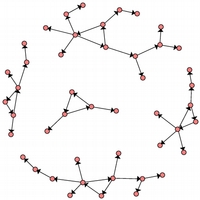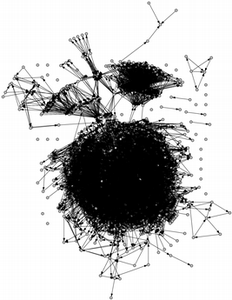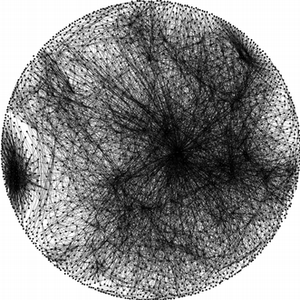|
Downloadspathpy»«pathpy
pathpy is an OpenSource python package for the modeling and analysis of pathways and temporal networks using higher-order and multi-order graphical models. The code, reference manual as well as an educational tutorial are available on gitHub. The package is specifically tailored to analyze sequential data which capture multiple observations of short, independent paths observed in an underlying graph topology. Examples for such data include user click streams in information networks, biological pathways, or traces of information propagating in social media. Unifying the analysis of pathways and temporal networks,
The theoretical foundation of this package, higher-order network models, has been developed in the following research works:
ETHBeamer»«ETHBeamer
Here we provide a class file, and the necessary backgrounds in order to create LaTeX presentations according to the ETHZurich format. The class supports both 4:3 and 16:9 aspect ratios, and the use of Helvetica fonts. It is based on the color palette provided by the Corporate Design (CD) Manual. The desired color is passed as a class option with it's respective name: ETH1-ETH9. An example .tex file is provided, to highlight the use of some default options. Important to know is that the colours Dark Blue ETH 1 and Dark Green ETH 2 are reserved for the corporate level, this applies normally to the Executive Board and the central authorities. Anyone addressing a target audience inside or outside ETH on behalf of a teaching or research entity, which applies for the usual case, should use one of the colours ETH 3 to ETH 9. Our class file is based on the general beamer class, so before proceeding make sure that you the beamer package is included in your LaTeX installation.
ETHBrief»«ETHBrief
The Chair of Systems Design has provided a template for the ETH Brief style for LaTeX. By the time of creation in 2005 there was only a general Microsoft Word template for the ETH Brief provided by the ETH. We filled this gap by providing an additional LaTeX template for those who not use Microsoft Word. Currently, ETH has build upon this template to create an updated version to match its new format requirements. You may get this new class from the ETH Corporate Communications website pyTempNet»«pyTempNet
pyTempNet is a python module for the analysis of time-stamped relational data represented as temporal networks. It particularly facilitates the analysis of temporal networks from the perspective of higher-order networks, which include causality limitations due to order correlations. This perspective and the resulting analytic measures have been outlined in the papers:
The module is written in pure python, has no platform-specific dependencies and should thus work on all platforms. The latest version can be installed by typing:
TutorialA detailed educational tutorial showcasing the features of AcknowledgementsThe development of this module was generously supported by the MTEC Foundation in the context of the project The Influence of Interaction Patterns on Success in Socio-Technical Systems: From Theory to Practice. ContributorsIngo Scholtes (project lead, development) Copyright(c) Copyright ETH Zürich, Chair of Systems Design, 2015-2016 NETVisualizer»«NETVisualizer
NETVisualizer is an OpenSource, OpenGL-based network and graph visualization framework for .NET 4.0 / Mono 2.10x and higher. Its main features are:
The fully documented source code is available on a dedicated gitHub project page. Please note that NETVisualizer shares parts of its OpenGL rendering backend with our graph layout software Cuttlefish. pyFastLayout»«pyFastLayout
pyFastLayout provides a highly efficient, parallel implementation of the Fruchterman-Reingold layout algorithm. The module has been implemented as a native C-extension to python. The module is freely available on gitHub. multinet.js»«multinet.js
Multinet.js is a visualization framework for large, dynamic and multi-layered graphs developed by the Chair of Systems Design at ETH Zurich. The front-end is based on three.js, while the back-end uses igraph and Flask to deliver layout information to the front-end. Our deployment of the framework can be accessed from this link. Multinet.js source code is freely available on gitHub. Licensemultinet.js is distributed under the terms of the BSD 3-Clause License. See LICENSE for details. ARF graph layout»«ARF graph layout
AbstractAs Networks and their structure have become a major field of research a strong demand to visualize these networks has emerged. We address this challenge by formalizing the well established spring layout in terms of dynamic equations. We thus opening up the design space for new algorithms. Drawing from the knowledge of systems design, we derive a layout algorithm that remedies several drawbacks of the original spring layout. This new algorithm relies on the balancing of two antagonistic forces. We thus call it ARF for "attractive and repulsive forces''. It is, as we claim, particularly suited for dynamic layout of smaller networks. We back this claim with several application examples from on going complex systems research.
PublicationMarkus M. Geipel: Self-Organization applied to Dynamic Network Layout,
DemonstrationsThe following video shows ARF at work. It addapts the layout to the constantly changing graph topology:
ARF was also used to visualize results in the field of innovation network research. The videos show simulations of the evolution of R&D cooperations between firms. They were presented on the WEHIA 06 conference. James Glattfelder produced a fancy 3D fly though video posted on YouTube.
The following graph shows class dependencies in an open source java project (circa 2500 classes). One layout was generated with neato and the other one with ARF (graph data)
If you achieve better layout results with neato then the one presented here, please let me know. In this case, I will gladly update the page. 



How to run the browser java ch.ethz.sg.arf.netbrowser.NetworkBrowserFrame The browser starts with an arbitrary random network. If you want to browse your own networks, just write a class that extends the ANetModel class. This way, you can plug any data source into the browser. See the comments in the code for details. To load your network, use the following command: java ch.ethz.sg.arf.netbrowser.NetworkBrowserFrame YourNetModelClass StartNodeId Please note, that the network browser and the ARF implementation are prototypical implementations. They are meant as a proof of concept and nothing more. However, you are free to use and extend the code unter the GNU General Public License as published by the Free Software Foundation.
Online Material»«Online Material
Here we provide online material related to publications. Firm Ownership Networks
Data»«Data
IRC-20ChannelsThe data are freely available for research purposes. If you make use of this dataset, please cite A. Garas, D. Garcia, M. Skowron, F. Schweitzer, Scientific Reports 2, 402 (2012). This dataset is provided as Supplementary Information for the article "Emotional persistence in online chatting communities" Emotional persistence in online chatting communities, 2012
Garas, Antonios;
Garcia, David;
Skowron, Marcin;
Schweitzer, Frank
OSS dependency networks These data on co-change and dependency networks of 35 JAVA projects are freely available for research purposes. If you make use of this dataset, please cite M.M. Geipel, F. Schweitzer: Software change dynamics: evidence from 35 java projects, ESEC/FSE '09 (2009). Please find the data here |
||||||||||||||||||||||